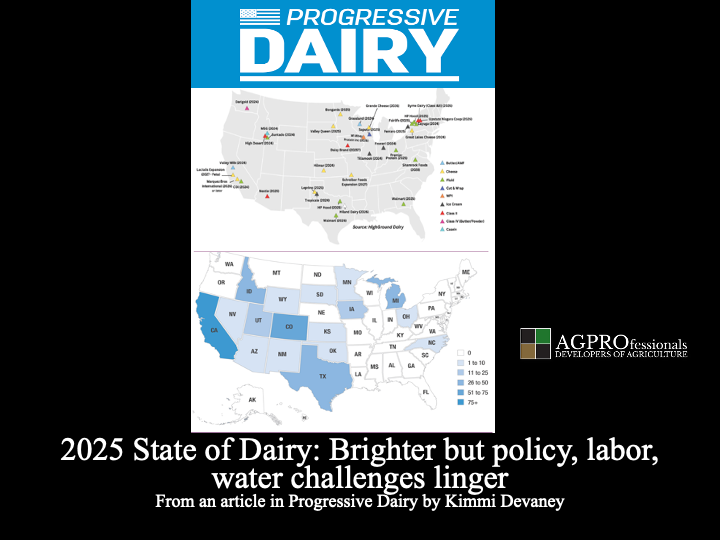“Many dairy producers across the U.S. are starting 2025 in a more optimistic state than a year ago. While attitudes ranged from upbeat and positive to cautious and uncertain, the majority were fairly hopeful for what is to come this year.
Much of this optimism stems from higher milk prices and stronger on-farm financial margins, which is providing many with some much-needed breathing room. It also has some dairy producers thinking about expansion and/or improving efficiencies on their operation in a variety of areas.
Dairy processing continues to be a bright spot for many regions as more new processing facilities come online across the nation
Several major cheese projects, mainly in the Great Plains states, will come online in 2025 or have started in the past two years.
“These locations offer lower costs due to local feed production and fewer environmental and water regulations than states like California,” says Betty Berning, contributing dairy economist for HighGround Dairy. “The new plants will require 20 to 25 million pounds of milk daily, equating to an additional 750 to 900 million pounds of cheese annually. It is expected that some older assets will shutter, which will offset some of the new capacity.”
To meet demand, Texas milk production has grown 15% since 2020, ranking third in 2024 and surpassing Idaho.
“While milk volumes are rising, these new plants will absorb much of the increase, potentially shifting milk pool dynamics,” Berning says. “The Southeast, which relies on surplus milk from this region, may face higher costs as supply sources shift farther away.”
Despite many areas bringing optimism to the industry, some challenges remain. On the policy front, a new administration in the White House and much uncertainty around immigration and other policies on the federal and state levels are causing some apprehension among those in the dairy industry. Water also continues to be a hot topic in California and across the Southwest. The recently-finalized Federal Milk Marketing Order (FMMO) final rule has some excited and others nervous. Read more about that within the regional and organic articles in the links found below.
As of Feb. 20, there have been 973 cases of highly pathogenic avian influenza (HPAI) H5N1 bird flu on dairy farms in 17 states, with 747 of those cases in California alone (Figure 2). Read how state veterinarians and animal health officials from the five states most affected by bird flu have handled the outbreak in their states. Dairy producers and industry leaders also share their experiences during the outbreak in most of the regional articles.”
Link: HERE

